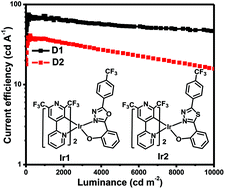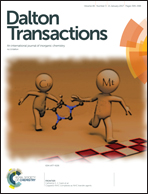Photoluminescence and electroluminescence of iridium(iii) complexes with 2′,6′-bis(trifluoromethyl)-2,4′-bipyridine and 1,3,4-oxadiazole/1,3,4-thiadiazole derivative ligands†
Abstract
Using 2′,6′-bis(trifluoromethyl)-2,4′-bipyridine as a monoanionic cyclometalated ligand, 2-(5-(4-(trifluoromethyl)phenyl)-1,3,4-oxadiazol-2-yl)phenol and 2-(5-(4-(trifluoromethyl) phenyl)-1,3,4-thiadiazol-2-yl)phenol as ancillary ligands, two new heteroleptic iridium(III) complexes (Ir1 and Ir2) were prepared and investigated. The ancillary ligand variations affected their emissions greatly, and the complexes Ir1 and Ir2 emitted green (503 nm) and orange (579 nm) lights, respectively. Moreover, the electron mobility of the two complexes is as high as that of the electron transport material Alq3 (tris-(8-hydroxyquinoline)aluminium), which is useful for their performances in organic light-emitting diodes (OLEDs). The OLEDs with Ir1 as the emitter showed excellent performances with a maximum current efficiency of 74.8 cd A−1, a maximum external quantum efficiency of 27.0%, a maximum power efficiency of 33.4 lm W−1, and the efficiency roll-off is mild. These results suggest that complexes with 1,3,4-oxadiazole/1,3,4-thiadiazole derivatives have potential application as efficient emitters in OLEDs.



 Please wait while we load your content...
Please wait while we load your content...